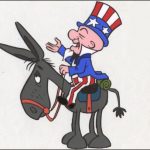
We’re now almost strictly into the television era (excepting a feeble effort from DePatie-Freleng discussed below). But at least some TV animators continued to find the proper “spirit” to celebrate Independence Day, and the revolution in general.

Uncle Sam Magoo (TV special, 2/15/70). It’s hard to know from the credits who provided the nuts and bolts to produce this film, as what was an official UPA studio should have been long gone. However, the UPA banner still appears, as does the production name of Henry Saperstein, and the direction credit of Abe Levitow (the original director of Magoo’s Christmas Carol). Familiar names Ray Patterson, Irv Spence, Phil Roman, and Xenia appear among the animation credits (could Hanna-Barbera have lent a hand here?). Whatever the production situation, the film is a largely forgotten but worthy successor to the original Christmas classic, obviously intended to permit Magoo to capture another holiday. Magoo is again portrayed in his acting career (which had provided the basis for the “Famous Adventures” series discussed previously), this time moving his attentions to Hollywood instead of his home Broadway. He is as bumbling as usual in the musical wraparounds as he invades the movie capitol in his classic jalopy. As he drives through a closed studio gate into a backlot of half-dismantled sets, he complains at the shoddy condition of a neighborhood “falling into ruin.” He crashes into and mistakes a gumball machine for a parking meter, refusing to put his “hard earned moola” into it. Misreading the last word of a sign reading “Costume Department Upstairs”, he believes he’s found the “UPA Studios”. Inside, he greets a clothes rack/mannequin as his agent, “Henry” (nod to producer Saperstein), then accidentally falls into and acquires his actual outfit for the evening – playing Uncle Sam.

He thinks he’s wearing clown suit, until a reflection of the real Uncle Sam comes to him in a mirror, stating with pride that the outfit served him well for nearly 200 years, Magoo, still all show biz, scoffs that this man could have had such a “long engagement”, but eventually receives inspiration from the reflection and captures the “spirit”, as he trips and falls into a spiraling halo of 13 stars that encircles his dizzy head, ushering in the body of our film. The hour is an enterprising potpourri of vignettes on American history, accomplished both in well posed and creative animation and visually-augmented photo montage, with a sizeable amount of laughs as well as respect for its material, well worthy of Levitow’s legacy if not UPA’s own reputation in general. It also covers quite a lot of ground, all the way from first landing by Leif Erikson (how many films properly give him credit?) through an oval office meeting with the current president – anonymously presented to fit any administration – with just about everything else in somewhat random chronological order inbetween, both factual and tall tale (including both Paul Bunyan and Johnny Appleseed). Magoo even gets to perform “I’m a Yankee Doodle Dandy”, adding to his usual expression with “By George – M. Cohan, that is.” Magoo is present through all of it, as both emcee and semi-participant. Portions of the film involving the American Revolution include a musical number for marching minute men, roused by Paul Revere, whom Magoo almost gives misguided road directions (“No, that’ll bring you back to Bunker Hill…”), the Boston Tea Party, Betsy Ross’s sewing of the flag (”We’ve got a winner there…it’s a grand flag” remarks Magoo), Ben Franklin and his kite, and an interesting vignette between Magoo and Francis Scott Key, where elements of the lyrics to “Star Spangled Banner” develop conversationally between the two’s inquiries as to the status of the battle (Magoo substantiating his end of the observations based upon his always having “20/20 vision”!). When all festivities finally wrap up, Magoo returns to his battered jalopy, and decides to contribute to his country after all by paying the “parking meter”. It “pays off” in a jackpot of gumballs which fill up the frame for a comedic fade out. A surprisingly engaging and entertaining sendoff of Magoo by what was left of the production team that knew him best – and a far cry above the quality of any later incarnation that has followed.
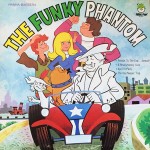 I make only glancing reference to Hanna-Barbera’s The Funky Phantom (1971-72), another in a semi-recurring stream of Scooby-Doo style knock-offs featuring a Revolutionary War ghost (Jonathan Wellington “Mudsy” Muddlemore) and his ghost cat Boo as the “mascots” in place of Scooby for more mystery solving. Seems Mudsy and cat hid from the redcoats in an old grandfather clock, then couldn’t get out until the kids freed them in modern times. The show never appealed to me, and I was not one of its regular viewers (for that matter, was anybody else?). Particularly offputting to me was that the studio couldn’t even find an original voice or personality for the Phantom – instead simply transplanting Daws Butler’s Snagglepuss voice intact into his ectoplasm. If anyone else knows of any highlights worth writing about on this series, they are welcome to do so. I exercise my right of freedom to pass.
I make only glancing reference to Hanna-Barbera’s The Funky Phantom (1971-72), another in a semi-recurring stream of Scooby-Doo style knock-offs featuring a Revolutionary War ghost (Jonathan Wellington “Mudsy” Muddlemore) and his ghost cat Boo as the “mascots” in place of Scooby for more mystery solving. Seems Mudsy and cat hid from the redcoats in an old grandfather clock, then couldn’t get out until the kids freed them in modern times. The show never appealed to me, and I was not one of its regular viewers (for that matter, was anybody else?). Particularly offputting to me was that the studio couldn’t even find an original voice or personality for the Phantom – instead simply transplanting Daws Butler’s Snagglepuss voice intact into his ectoplasm. If anyone else knows of any highlights worth writing about on this series, they are welcome to do so. I exercise my right of freedom to pass.
Pinky Doodle (DePatie-Freleng/UA, Pink Panther, 5/28/76 – Sid Marcus, dir.) is a largely uninspiring effort to have the Panther cash in on the bicentennial. Pink is “saddled” with the task of circulating flyers (since he can’t talk at this point in his career) that the redcoats are coming. For this, he needs a steed. This is pretty much all the plot points we get, as the setup mirrors and allows for reuse of some animation from the earlier entry, “Pinto Pink”, with a horselaffing horse who continually foils Pink’s plans to mount him. A few encounters with the redcoats are tossed in to keep the cartoon on subject. Perhaps the best gag has the redcoat horse change hats with the colonist chapeau Pink wears, causing the townsfolk to shoot at Pink even as he spreads the warning. A protracted sequence has Pink become water-logged from being pumped through a well, an accumulation of water protruding within and ultimately bursting through his tail. After medics rush him to an emergency room, a surgeon seeming to be readying himself for an elaborate procedure merely applies a band-aid, then attempts to turn in Panther to the redcoats. In the final scene, Pink revisits the gag, as he dangles from the clapper of the Liberty Bell, dislodging it from a steeple and causing it to crack. From within the enclosure of the bell, Pink’s hand protrudes from the crack and applies two large band-aids to “heal” the damage. While the cartoon was unremarkable, the studio must have felt it could do seasonal duty when it became short for quota in its final years, and the film was reissued with only five superfluous new shots (sort of the same tactic used in the “cheaters” of the final years of production of the Three Stooges shorts) as Yankee Doodle Pink on 12/2/78.
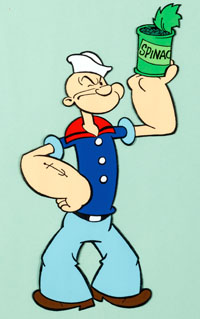 The Midnight Ride of Popeye Revere (Hanna-Barbera, The Popeye and Olive Comedy Show, circa 1981) twists history up considerably. This time telling the tale of his historic ancestor to Pipeye, Poopeye, Peepeye and Pupeye, Popeye tells of the famous Boston silversmith who “takes a shine” to his silver. Outside, a call of “The British are coming” is heard. The town crier, however, is Wimpy, whose mouth is too often filled with hamburgers to be clearly understood, and whose tummy is so filled with burgers from under his hat that he is in no mood to ride. Popeye, instead of traveling to every Middlesex village and farm, plans to signal the minutemen (actually Olive minutewoman and the nephews as the four minuteboys) with lanterns from the Old North Church. Climbing onto a horse, Popeye asks Wimpy if the British are coming by land. Wimpy quips, “They ain’t coming by air.”
The Midnight Ride of Popeye Revere (Hanna-Barbera, The Popeye and Olive Comedy Show, circa 1981) twists history up considerably. This time telling the tale of his historic ancestor to Pipeye, Poopeye, Peepeye and Pupeye, Popeye tells of the famous Boston silversmith who “takes a shine” to his silver. Outside, a call of “The British are coming” is heard. The town crier, however, is Wimpy, whose mouth is too often filled with hamburgers to be clearly understood, and whose tummy is so filled with burgers from under his hat that he is in no mood to ride. Popeye, instead of traveling to every Middlesex village and farm, plans to signal the minutemen (actually Olive minutewoman and the nephews as the four minuteboys) with lanterns from the Old North Church. Climbing onto a horse, Popeye asks Wimpy if the British are coming by land. Wimpy quips, “They ain’t coming by air.”
Popeye’s ride is indeed short, as redcoat Bluto quickly spots him, shouting, “Halt, you minute (pronounced mi-noot) minuteman!” Popeye trips Bluto up with a tree branch, but his horse gets away, causing Popeye to proceed on foot. Popeye crosses a small foot bridge across a river. Bluto saws away at the bridge a few feet from one cliff face. The rest of the bridge ahead of him falls away, dangling from the opposite cliff by ropes. But Popeye merely scales it in erect walk at a vertical right-angle, defying gravity – “This is sure a steep way to the steeple.” “He’s supposed to fall”, Bluto complains – as his piece of the bridge drops out from under him. “Like this”, he continues, drenched in the river bed. Bluto catches up to Popeye and slams down a crate of tea upon him. “I thought you was a fighter”, Popeye shouts from inside. “Yeah, a boxer!” replies Bluto, tossing the crate into the river. As the crate sinks, Popeye says, “Give me liberty, or give me breath.” His pipe rises as a periscope and snorkel, and he rows along underwater as a submarine. As he rows, he passes a longboat full of British troops. “Those foolish Americans think we’re coming by land” remarks a captain aboard. Popeye realizes the reconnaissance info was wrong, and two lanterns are needed for the proper signal.
Bluto, disguised in a bale of hay, gives chasse as Popeye reaches land. They run in circles around the church steeple. “He’s giving me the runaround”, says Bluto. “I calls it revolution”, replies Popeye. “I’ll give that redcoat a real steeplechase.” Popeye finally hides in a barrel, which Bluto rolls down a hill. The plan backfires, as a curving ledge at the foot of the hill launches the barrel skyward, right into the steeple tower. But Bluto climbs the tower before Popeye can hang the lanterns, and catches him in a rope lasso, tying him to the clapper of one of the church bells. “Hail, hail, the gong’s all here”, he gloats, clanging Popeye loudly against the bell’s insides, then pushing so hard, the bell falls from its hinges out the steeple and onto the grounds below. Meanwhile, to add confusion to the patriots’ efforts, Bluto hangs one lantern to give the wrong signal. Inside the bell below, Popeye finds the ground it has fallen upon to be covered in – what else – spinach. Popeye cracks through the side of the bell – anyone for an historic relic for Independence Hall? Popeye jumps on a loose floorboard in the steeple, launching Bluto through the roof, while Popeye properly hangs the missing second lantern. Wimpy, who has finally caught up with the festivities, observes from the lanterns that the British are coming by sea – just as Bluto lands with a thud in front of him. “By George. One did come by air!” As present-day Popeye concludes his story, he finds the four nephews have dressed in patriotic attire, one carrying the flag while the other three replicate the “Spirit of ‘76″ fifer and drummers. “The story I reads musta gone to their heads, says Popeye the minuteman”, Popeye sings for the iris out.
 The Birth of the Constitution (Lee Mendelson/Bill Melendez, Peanuts Special, 10/28/88), the second of the historically-themed episodes from the miniseries, This Is America, Charlie Brown, fares better than its predecessor, “The Mayflower Voyagers” (reviewed in my previous post, “How Grim Was My Pilgrim”). While casting the Peanuts gang as Pilgrim settlers presented such a bleak setting that the personalities of the characters seemed constrained and overly restricted, the gang as early patriots in the days following the Revolutionary War, while still an unlikely place to find them, allowed more “freedom” to be themselves, and a chance to sprinkle some humor amidst the historical references. The gang take jobs assisting in various ways the delegates at the Constitutional convention. Snoopy (official sentry/guard) gets some humorous sidelights whooping it up with Woodstock, as they model in a mirror inside Snoopy’s doghouse hairpieces from Snoopy’s collection of formal powdered wigs. They travel to the convention hall by rowboat, with Snoopy assuming a pose a la standing George Washington in the bow – tipping the bow-heavy craft so that rower Woodstock rows the boat nose-first straight under the water. Lucy expresses her opinion on how the government should be run, suggesting what they need is a queen (herself intended as a candidate).
The Birth of the Constitution (Lee Mendelson/Bill Melendez, Peanuts Special, 10/28/88), the second of the historically-themed episodes from the miniseries, This Is America, Charlie Brown, fares better than its predecessor, “The Mayflower Voyagers” (reviewed in my previous post, “How Grim Was My Pilgrim”). While casting the Peanuts gang as Pilgrim settlers presented such a bleak setting that the personalities of the characters seemed constrained and overly restricted, the gang as early patriots in the days following the Revolutionary War, while still an unlikely place to find them, allowed more “freedom” to be themselves, and a chance to sprinkle some humor amidst the historical references. The gang take jobs assisting in various ways the delegates at the Constitutional convention. Snoopy (official sentry/guard) gets some humorous sidelights whooping it up with Woodstock, as they model in a mirror inside Snoopy’s doghouse hairpieces from Snoopy’s collection of formal powdered wigs. They travel to the convention hall by rowboat, with Snoopy assuming a pose a la standing George Washington in the bow – tipping the bow-heavy craft so that rower Woodstock rows the boat nose-first straight under the water. Lucy expresses her opinion on how the government should be run, suggesting what they need is a queen (herself intended as a candidate).
Charlie Brown, who complains in normal times of having too much work to do anything, gets the cushy assignment of valet-parking the delegates’ horses, and finds time inbetween to attempt to invent “new” games – coming up with predecessors of his favorite usual sport (baseball), an attempt at basketball (except he can’t figure out what should happen next after the ball gets thrown into a peach basket in a tree), and even cricket (which Lucy changes the rules of to convert it to “kickball” – allowing her the first chance to pull the ball away from Charlie Brown on the kickoff). Charlie Brown’s “expertise” is even sought out by, of all people, Benjamin Franklin, who requests him to construct a kite for Franklin’s great experiment. Ben returns to the door after a few sharp bolts of lightning outside, appearing well singed, with the kite blasted and a gaping hole in its center, and announces the experiment a success. On the historic side, the special features something for the adults – engaging recreations of the debates inside the hall, showcasing the myriad of opinions on every branch of government the debaters waded through during their months-on-end of squabbling and bickering before a consensus was finally struck. At times, the debate sounds almost as polarized as modern-day congressional sessions – and we think we’re the only generation whose leaders have trouble accomplishing anything! As Linus’s narration recounts, the convention started with nearly half the delegates not even in attendance yet – and many delegates left long before the Constitution was penned. Yet somehow the job got done. It’s an interesting story of perseverance, and, with so many viewpoints under discussion, most containing at least half-truths for their foundation, one can wonder how easily the end result might have turned out drastically different with just a swayed opinion or two here and there.
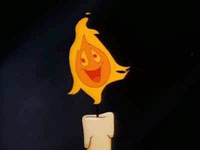 Steven Speilberg’s Animaniacs produced three cartoons with the appropriate “Spirit” for this article. An interesting one-shot title was The Flame (10/11/93). A strike of a match in the darkness produces a glowing spark at the end of an antique-stlye candle wick mounted in a stand with handle for carrying. From the glow grows a personable little ball of fire with face, who can periodically use extensions of his flickering luminence as hands, and talks in an engaging little-boy voice. He speaks as if communicating with the owner of the hand who brought him to life, though it actually becomes apparent (to only the audience) that the man is only talking to himself, and never hears a word the flame says. Yawning as he comes to life, the flame says, “Is it hot in here?, I definitely feel warm.” Turning around, he sees his reflection in a mirror/ “Oh my gosh, there’s a fire!” Attempting to shout an alarm for somebody to put it out, he finally realizes, “I am a fire. Imagine my embarrassment. I wish someone would tell me these things. I’m always the last to know.” As his master picks up the candle-holder and walks through a dark corridor, the flame thinks he’s being provided a guided tour of the place. Arriving at a darkened staircase, the flame begs not to be taken upstairs, as he’s afraid of the dark. But, as his owner mounts the steps, he realizes things are getting lighter, and looking back, thinks he scared the darkness into hiding downstairs. The man enters an antique-style study, and the candle is placed on a writing desk. “Burning the midnight oil, huh?”, observes the flame. “No problem. I’ll keep you company.” A cool breeze from an open window causes his light to wiggle and flicker. ”I was born to dance”, comments the flame, as his light makes the shadows behind male and female figurines on a high shelf appear to dance the minuet.
Steven Speilberg’s Animaniacs produced three cartoons with the appropriate “Spirit” for this article. An interesting one-shot title was The Flame (10/11/93). A strike of a match in the darkness produces a glowing spark at the end of an antique-stlye candle wick mounted in a stand with handle for carrying. From the glow grows a personable little ball of fire with face, who can periodically use extensions of his flickering luminence as hands, and talks in an engaging little-boy voice. He speaks as if communicating with the owner of the hand who brought him to life, though it actually becomes apparent (to only the audience) that the man is only talking to himself, and never hears a word the flame says. Yawning as he comes to life, the flame says, “Is it hot in here?, I definitely feel warm.” Turning around, he sees his reflection in a mirror/ “Oh my gosh, there’s a fire!” Attempting to shout an alarm for somebody to put it out, he finally realizes, “I am a fire. Imagine my embarrassment. I wish someone would tell me these things. I’m always the last to know.” As his master picks up the candle-holder and walks through a dark corridor, the flame thinks he’s being provided a guided tour of the place. Arriving at a darkened staircase, the flame begs not to be taken upstairs, as he’s afraid of the dark. But, as his owner mounts the steps, he realizes things are getting lighter, and looking back, thinks he scared the darkness into hiding downstairs. The man enters an antique-style study, and the candle is placed on a writing desk. “Burning the midnight oil, huh?”, observes the flame. “No problem. I’ll keep you company.” A cool breeze from an open window causes his light to wiggle and flicker. ”I was born to dance”, comments the flame, as his light makes the shadows behind male and female figurines on a high shelf appear to dance the minuet.
The wind, however, increases. “Whoa, it’s a tornado. Batten down the hatches!”, he shouts, clutching desperately to stay attached to the candle. With effort, his master finally shuts the sticking window frame, but as he attempts to retrieve the papers he’s been writing, knocks the candle from the desk. “Mayday! We’re goin’ down”, shouts the flame. Landing sideways, a circle of sparks begin to ignite atop the papers on the floor and dance around. “Hey, you guys, are you crazy?”, remarks the flame. “Knock it off.” As the papers ignite, the man pours a pitcher of water upon them, quenching all but the candle. The flame claims he didn’t do it. It was his “evil cousins”, and advises to next time, “Be more careful. My relatives can’t be trusted.” Seemingly at the flame’s suggestion, his master gets “back to work. You keep on writing, and I’ll keep the darkness away.” Dawn finally breaks. The flame now rests atop a candle that has melted almost to its final stub. “Finished”, comments the human author, writing in the final words with a quill. Seeing what he wrote, the flame reads aloud the first sentence of the paper – the Declaration of Independence. It’s author, finally seen, signs his name in the corner. “Not bad, Jefferson”, congratulates the flame. Thomas takes the paper to the other patriots, and John Hancock signs and dates the instrument. “Good luck with that independence thing”, says the flame encouragingly, then yawns. “As for me, I’m going to take the rest of the day off. Maybe you should do the same. We could call it a national holiday.” He goes out and disappears. The scene dissolves to a subsequent year of celebration, with a traditional fourth of July fireworks display. On the end of another candle, the flame enters the scene for a moment, closing with the line, “I guess they took my advice.”
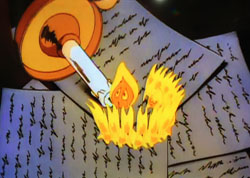 The Flame Returns (11/1/95), from a subsequent season, is visually inspiring, but far less creative, as the flame provides the light for the writing of Henry Wadsworth Longfellow’s recounting of Paul Revere’s Ride. The flame recites virtually the entire poem in non-humorous fashion, with periodic cameos among the visuals for most of the Animaniacs cast of characters, also in non-humorous form. The film is thus a harken-back to Old Glory, with rich background work, though its animation is less meticulous and costly than its theatrical predecessor – and in some respects, it gives one more the feeling of the “Famous Adventures of Mister Magoo” retelling. Appropriate viweing for the holiday, but not of the universal appeal of the flame’s first appearance.
The Flame Returns (11/1/95), from a subsequent season, is visually inspiring, but far less creative, as the flame provides the light for the writing of Henry Wadsworth Longfellow’s recounting of Paul Revere’s Ride. The flame recites virtually the entire poem in non-humorous fashion, with periodic cameos among the visuals for most of the Animaniacs cast of characters, also in non-humorous form. The film is thus a harken-back to Old Glory, with rich background work, though its animation is less meticulous and costly than its theatrical predecessor – and in some respects, it gives one more the feeling of the “Famous Adventures of Mister Magoo” retelling. Appropriate viweing for the holiday, but not of the universal appeal of the flame’s first appearance.
And, Pinky and the Brain get into the act, with Don’t Tread on Us (11/1/95). Cast in Colonial days, the megalomaiac mouse and his dimwitted assistant arrive in the New World on board the very ship which is to become the victim of the Boston Tea Party – and of course are thrown into the bay. “Ummm…Earl Grey”, comments Pinky at the taste of the water. A sarcastic, “One lump or two?” from Brain is answered by a second crate landing on top of them and squashing them flat. Brain ultimately concocts a scheme to launch into the room where the Declaration of Independence is to be signed a substitute document for the old switcheroo, including Brain’s own clause appointing him the nation’s leader. But Pinky’s trajectory by slingshot is blocked by the head of Benjamin Franklin, who picks up the doppleganger document and decides it’s perfect paper to make a kite from. Pinky and Brain skitter up the kite string to rescue their precious parchment, and receive the same electrical treatment as Amos Mouse in “Ben and Me”. The paper destroyed, and Brain’s plan crushed, they leave for France to try their luck taking over in the French Revolution, as the film fades out using the international “Fin” instead of “The End”.
The Midnight Ride of Pink Revere (“The Pink Panther“ television series, 10/7/93). Finally! A good episode from the dialogue-heavy version of the series starring Matt Frewer, with Pink’s dialogue kept to a reasonable minimum, animation outclassing the 1976 episode described above, and some clever and funny bits. Pink is among the tryouts for minuteman, a la Hector Heathcote. Sergeant Bignose uses Paul Revere as his example student to show the raw rookies how it’s done. Paul, a square-chinned born-hero type, takes an instant dislike to Panther, ribbing him with the nickname “lackey”. He demonstrates rifle shooting at a distant target, scoring within but far from center of the bulls’ eye. Then the rifle is tossed to Pink. Pink shakes like a leaf, hoping to make the grade, and fires a shot. The bullet hits a rock, a horseshoe over a barn, and various other objects, also knocking a bees’ nest squarely down on Revere’s head, then reaches the target dead center. Aching with welts from the bee stings, Revere sneers through his teeth at Pink, “Lucky shot.” In his next test, a stopwatch test to see how fast Pink can rise to action from out of bed, Revere tries for revenge by nailing Pink’s boots to the floor.
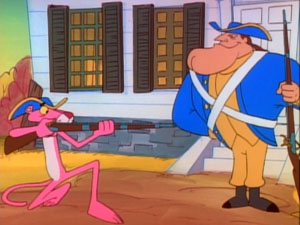 Pink struggles against the boots as time ticks away, but appears out the door with the floorboards ripped up, riding them like skis. Clicking the stopwatch, Revere states, “Exactly one minute – and five seconds!” A discouraged Pink is shown the one opening the regiment has left for him – stable boy. Pink attends to his new duties, offering Revere’s horse a new crate of horseshoes in designer colors. Revere polishes his shoes on Pink’s back, bragging that he must be tidy when he warns the villagers, and dreaming of the fame and glory he will receive. “Why, I’ll be – REVERED!” He then rehearses for his dramatic yell to the townspeople – but hasn’t decided on his dialogue line yet. “The British are – expected! The British are arriving unannounced!” Pink’s suggestion of “The British are coming” is dismissed by Revere as “How lame”, as Revere continues, “The British are crashing the party!” Outside, a longboat of redcoats rows into the harbor. Their General reminds them to take advantage of the element of surprise. One soldier (using the voice and Liverpool accent we remember as Wakko Warner from Animaniacs), asks, “Then why do you wear bright red and march to a loud drum beat in a perfectly straight line?” Straightening the soldier’s hat, the General replies, “Neatness always counts.” Back at the stable, Pink struggles to pry off the old shoes from Revere’s horse. Outside, Paul sees the lights from the Old North Church, but is still unrehearsed for his lines, and gets stage fright. “The skittish are bumming! The Yiddish are humming!” As he approaches the stable, he is met with a loud clank. The horseshoe has given way, flying through the air, and landing a blow right on Paul’s forehead. Paul collapses in a heap, and neither a dousing with water, smelling salts, nor a dunk in the horse trough will revive him. Knowing someone must give the warning, Pink removes and commandeers Paul’s uniform, as well as his horse. “Is this gonna be cool or what?”, says Pink.
Pink struggles against the boots as time ticks away, but appears out the door with the floorboards ripped up, riding them like skis. Clicking the stopwatch, Revere states, “Exactly one minute – and five seconds!” A discouraged Pink is shown the one opening the regiment has left for him – stable boy. Pink attends to his new duties, offering Revere’s horse a new crate of horseshoes in designer colors. Revere polishes his shoes on Pink’s back, bragging that he must be tidy when he warns the villagers, and dreaming of the fame and glory he will receive. “Why, I’ll be – REVERED!” He then rehearses for his dramatic yell to the townspeople – but hasn’t decided on his dialogue line yet. “The British are – expected! The British are arriving unannounced!” Pink’s suggestion of “The British are coming” is dismissed by Revere as “How lame”, as Revere continues, “The British are crashing the party!” Outside, a longboat of redcoats rows into the harbor. Their General reminds them to take advantage of the element of surprise. One soldier (using the voice and Liverpool accent we remember as Wakko Warner from Animaniacs), asks, “Then why do you wear bright red and march to a loud drum beat in a perfectly straight line?” Straightening the soldier’s hat, the General replies, “Neatness always counts.” Back at the stable, Pink struggles to pry off the old shoes from Revere’s horse. Outside, Paul sees the lights from the Old North Church, but is still unrehearsed for his lines, and gets stage fright. “The skittish are bumming! The Yiddish are humming!” As he approaches the stable, he is met with a loud clank. The horseshoe has given way, flying through the air, and landing a blow right on Paul’s forehead. Paul collapses in a heap, and neither a dousing with water, smelling salts, nor a dunk in the horse trough will revive him. Knowing someone must give the warning, Pink removes and commandeers Paul’s uniform, as well as his horse. “Is this gonna be cool or what?”, says Pink.
Revere’s stallion turns out to be hard to handle. As the first village is reached, the horse darts through so fast, Pink doesn’t even have time to complete his sentence of warning. He yells for the horse to whoa, and he does – stopping on a dime, and tossing Pink into a mud puddle. “Great! I get the only horse in the colonies without anti-lock brakes.” Returning to the village on foot, Pink has no end of trouble rousing the villagers. At the George and Martha Inn, a bucket of water is dumped on his head. Upgrading to the instrumentation of a one-man band, Pink is pelted with tomatoes, and yells back, “Critics!” A rooster suit and a loud “Cock-a-doodle doo!” only gets his “beak” stuffed up with a flying flower pot. He finds posters in the town square giving a clue to the minutemen’s whereabouts: “Minuteman Party – Bring Your Own Musket”. At the town hall, he finds the regiment – but is arrested by Bignose for knocking out Paul and stealing his horse. Placed in stocks, Pink grumbles at the disgrace – but more importantly because his nose itches. With his tail, he manages to loosen a pin securing the stocks to the post, and, with his hands and head still encased in wood, sets out to do what he can to fend off the British. The British troops have now landed, and, seeing the odd sight of Pink approaching in stocks, comment “Strange military maneuver. Ready, aim, fire, and all that rot.” Pink ducks the shots, stating, “I have not yet begun to – run away!” He retreats into a shed, which turns out to contain powder and muskets. Lighting a candle with his tail, he utters a loud raspberry to the troops outside to get them to advance closer, while lighting the fuse to a powder keg with the candle. But he miscalculates the width of his stocks, and gets wedged in the shed doorway before making an escape, also leaving him out of reach to stop the fuse. The explosion launches Pink into the sky, but also breaks the lock on the stocks. Using Paul’s jacket as a combination glider and parachute, and the stock halves as wings, Pink power dives on the redcoats, who, marching in their usual straight line, are bowled down like a row of dominoes. The General orders a retreat, and the troops scurry back into their longboat and row for their ship. The Liverpool soldier is heard: “General, did we win the battle”“ ”Oh, shut up and paddle, you twit”, replies the General. Paul Revere, who has finally come to and located his horse, picks this untimely moment to arrive on the scene. “The British are – going?” Pink comes in for a soft landing, and Bignose bestows upon him the rank of minuteman. “Of course, there is the matter of you pilfering my horse”, reminds Paul, “but I’ll overlook the entire affair” – then whispers to Pink, “if you give me the credit for the midnight ride and all. I mean in a hundred years, who’s gonna remember anyway?” Pink agrees – but just for fun, slaps Paul’s horse with the command of “Giddyap”. The horse runs off out of control again, with Paul shouting, “Whoa! Bad horsey!”, and Pink giving the audience s Groucho/Bugs Bunny-style raising of eyebrows and smile for the iris out. For once, the writers did their job. Clever all the way.
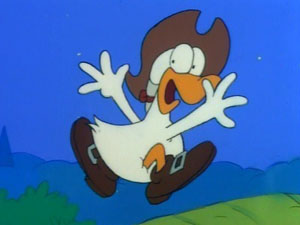 The Midnight Ride of Paul Revere’s Duck (10/23/93), a U.S. Acres episode from Garfield and Friends, has a few brilliant new twists. Roy Rooster is fed up at receiving only one fan letter, while born coward Wade Duck receives multiple truckloads. Roy determines to get on the show this week, one way or the other. Finding that Orson Pig is planning on reading to the chicks Sheldon and Booker Longfellow’s “Midnight Ride of Paul Revere” (which the chicks soon categorize as “Bor-ing!”), Roy quickly types his own rewrite, then “hogs” in on Orson’s reading session to present his own recitation, starring Wade. In Roy’s twisted-up tale, Paul Revere goes calmly to sleep, convinced that the British will not invade tonight, while his pet duck (Wade) is none too sure. Wade consults with town cryer Bo sheep, requesting a warning-signal system in terms far more complicated than the original poem. “One if by land, two if by sea. Three is they swing from a vine on a tree. Four if the British invadeth by plane. Five if they come on a skateboard or train. Six if by camel, by bus or by rail. Seven if sent here by overnight mail. Eight if they swim underwater like shrimp. Nine if they get here by zeppelin or blimp. Ten if by skiing, eleven by van. Twelve with the pizza delivery man. Thirteen by rowboat, a yacht, or canoe. Fourteen if hopping in a kangaroo. Whichever of these, or some other not named, I shall be in hiding, most deeply ashamed!”
The Midnight Ride of Paul Revere’s Duck (10/23/93), a U.S. Acres episode from Garfield and Friends, has a few brilliant new twists. Roy Rooster is fed up at receiving only one fan letter, while born coward Wade Duck receives multiple truckloads. Roy determines to get on the show this week, one way or the other. Finding that Orson Pig is planning on reading to the chicks Sheldon and Booker Longfellow’s “Midnight Ride of Paul Revere” (which the chicks soon categorize as “Bor-ing!”), Roy quickly types his own rewrite, then “hogs” in on Orson’s reading session to present his own recitation, starring Wade. In Roy’s twisted-up tale, Paul Revere goes calmly to sleep, convinced that the British will not invade tonight, while his pet duck (Wade) is none too sure. Wade consults with town cryer Bo sheep, requesting a warning-signal system in terms far more complicated than the original poem. “One if by land, two if by sea. Three is they swing from a vine on a tree. Four if the British invadeth by plane. Five if they come on a skateboard or train. Six if by camel, by bus or by rail. Seven if sent here by overnight mail. Eight if they swim underwater like shrimp. Nine if they get here by zeppelin or blimp. Ten if by skiing, eleven by van. Twelve with the pizza delivery man. Thirteen by rowboat, a yacht, or canoe. Fourteen if hopping in a kangaroo. Whichever of these, or some other not named, I shall be in hiding, most deeply ashamed!”
Wade darts back inside and hides between Paul’s shoes under his bed. But as the evening wanes on, the sound of troops (portrayed as Orson’s rough tough “brudders” from the series) is heard outside. Bo, so confused by Wade’s code, has never figured out how to give the signal. When Wade can’t arouse Paul from slumber, he ducks back under the bed for more hiding, until he is scared outside by the sight of a cockroach. Bumping into the British, he attempts a retreat, stumbling through Revere’s trash cans, and slipping on a banana peel. The slip lands him squarely on the back of Paul Revere’s horse, who breaks free of his hitching post and takes off, with terrified Wade along for the ride. Wade screams at the top of his lungs for the horse to whoa and let him off, as the horse travels past every Middlesex village and farm. No one in the villages understands what Wade is yelling, but it’s enough to wake them all into the streets, where they meet the British and history is appropriately made. Back in the present, all the cast except Roy scoff at his story, as entirely made up. Wade most vociferously of all insists such a thing could never happen – then slips on a banana peel, lands on a horse, and rides helplessly over the horizon, yelling “Art imitating life, y’know!” Roy offers no assistance whatsoever, stating, “All I care is, it got me on the show this week.”
Steven Spielberg’s Histeria! series actually managed to turn out a couple of more-acceptable-than-normal comic takes on The American Revolution (Parts 1 and 2) (9/1/98 amd 9/25/98). The two episodes actually play as if they should have been produced in reverse order, with the key action in part 1, and only incidental events in part 2 – sort of an afterthought. Part 1 introduces George Washington as the colonial counterpart of Bob Hope, in a random song and dance sequence on a stage made from the front porch of his colonial mansion. (He is periodically interrupted by a demented tour guide who was a series regular, Miss Information, who insists he was named after the Washington Monument.) Segment two is a retelling of the crossing of the Delaware, set in rhyming meter parodying “The Night Before Christmas”, with the Hessians surprised in the morning by a lawn full of Trojan Christmas packages, each containing a cannon and bayonet-wielding patriots. The battle of Yorktown provides segment three – built up with all the hype and glitz of a Super Bowl, complete with play-by-play announcers mimicking John Madden and Pat Summerall (interrupted at intervals by an Infomercial from Molly Pitcher promoting the thirst-quenching benefits of water). One clever line during the commentary comes from a cutaway to the redcoats’ latest “free-agent” – Benedict Arnold (voiced in impression of Woody Allen), who states “I just want to take this opportunity to state that I’m not a traitor – I’m just patriotically challenged.”
Part 2 is much more disjointed. George and Martha Washington perform a production number – “I cannot tell a lie.” George provides satisfied customer testimonials on the benefits of false teeth. Segment two highlights the Boston Tea Party – with cutaways to real native Americans (who speak like Jim Backus) criticizing the colonists use of stereotypical portrayals during the event – yet break into classic war whoops when captivated in a game of Yachtzee. The best moments come when Samuel Adams runs interference for the patriots dumping the tea overboard, by intercepting a snooping redcoat officer (voiced like John Cleese) with a fake admission booth to the tea party. The redcoat wants an admission, and keeps asking for every kind of tea imaginable. Of course, as all of it is in the process of being dumped overboard, Adams repeatedly replies that they are fresh out on every variety.
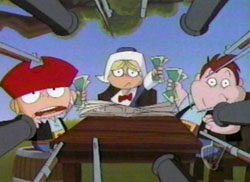 Finally, the foul deed done, Adams and company abandon the event, knocking the redcoat into the bay, where he finally gets his fill of tea in the water. “Not bad. Could use some sugar.” Adams obliges, by dropping a sack of sugar on his head. “Thank you”, the redcoat groggily remarks. (An interesting Disney reference also appears in a cutaway, as an ersatz Alice in Wonderland and an Ed Wynn-style voiced Mad Hatter refer to this tea party as “curioser and curioser”.) The final segment parodies “Nightline” with “Midnight Line”, with an exclusive interview of Paul Revere, turning the tale of the Longfellow poem upside down, as his horse (a rental) testifies that portly Paul was too busy stuffing his face with food during the ride to be understood by anybody, and was so heavy the horse had to apply for worker’s compensation. William Dawes (sounding like Captain Kirk of the Enterprise) and Samuel Prescott appear to reveal their assisting roles in the ride, armed with lawsuits filed for compensation for their lack of proper credit. Longfellow himself is asked why credit wasn’t given, and replies that he was stumped for rhymes to the name Prescott. The interview develops into a brawling free-for-all, with onlooking British soldiers also involved in the expose betting on the winner.
Finally, the foul deed done, Adams and company abandon the event, knocking the redcoat into the bay, where he finally gets his fill of tea in the water. “Not bad. Could use some sugar.” Adams obliges, by dropping a sack of sugar on his head. “Thank you”, the redcoat groggily remarks. (An interesting Disney reference also appears in a cutaway, as an ersatz Alice in Wonderland and an Ed Wynn-style voiced Mad Hatter refer to this tea party as “curioser and curioser”.) The final segment parodies “Nightline” with “Midnight Line”, with an exclusive interview of Paul Revere, turning the tale of the Longfellow poem upside down, as his horse (a rental) testifies that portly Paul was too busy stuffing his face with food during the ride to be understood by anybody, and was so heavy the horse had to apply for worker’s compensation. William Dawes (sounding like Captain Kirk of the Enterprise) and Samuel Prescott appear to reveal their assisting roles in the ride, armed with lawsuits filed for compensation for their lack of proper credit. Longfellow himself is asked why credit wasn’t given, and replies that he was stumped for rhymes to the name Prescott. The interview develops into a brawling free-for-all, with onlooking British soldiers also involved in the expose betting on the winner.
 There’s probably a lot to say about Liberty’s Kids (DIC/PBS, 2002-03). And it seems like most of it’s been said on various Wikipedia and fan pages to which I defer. At 40 episodes in duration, while my viewpoints on the series are based on the viewing of the single premiere episode, I do not feel fully qualified to pass judgment. The series seems to have been an enterprising effort to make American history more palatable to the middle-school crowd who was, like most kids, probably bored to tears in hitting the books alone. It’s the kind of thing I would think would fit better screening in school assemblies or as homewrk assignments rather than as a ratings getter – and it probably never strived much to be the latter. Told in continuing story fashion, it’s played pretty much dead straight, but with reasonably impressive animation and background work for a TV production. In my opinion, the episodes take some “liberties” of their own – for example, use of a freed slave (Moses) who speaks with perfect grammar and diction without a trace of regional or ethnic dialect, despite having no background specified in his bio information which would account for these unusual traits.
There’s probably a lot to say about Liberty’s Kids (DIC/PBS, 2002-03). And it seems like most of it’s been said on various Wikipedia and fan pages to which I defer. At 40 episodes in duration, while my viewpoints on the series are based on the viewing of the single premiere episode, I do not feel fully qualified to pass judgment. The series seems to have been an enterprising effort to make American history more palatable to the middle-school crowd who was, like most kids, probably bored to tears in hitting the books alone. It’s the kind of thing I would think would fit better screening in school assemblies or as homewrk assignments rather than as a ratings getter – and it probably never strived much to be the latter. Told in continuing story fashion, it’s played pretty much dead straight, but with reasonably impressive animation and background work for a TV production. In my opinion, the episodes take some “liberties” of their own – for example, use of a freed slave (Moses) who speaks with perfect grammar and diction without a trace of regional or ethnic dialect, despite having no background specified in his bio information which would account for these unusual traits.
Another black female (an author who is still a slave) is introduced in episode 1 as having received special schooling through the assistance of her owners – yet, after again speaking perfect unaccented English, somehow receives a line of dialogue where she uses the term “vittles”, standing out like a sore thumb as a word we would never expect to be in her vocabulary. Even more out of place is a middle-section of the series’ theme, which is performed in the style of a rapper! The producers thus seem to be unable to construct a convincing balance between desires to be both contemporary and politically correct and maintaining historical accuracy. On the other hand, an interesting concept is the inclusion among the “kids” of Sarah, a prim and proper Britisher just off the boat, proclaiming steadfast loyalty to the crown, yet ethically torn and being gradually lured to the colonists’s side at the events and outrages she witnesses. Sarah presents as much as possible the British point of view, without letting her reach the unpopular point of total dismissal of the colonist’s cause a the work of traitors. The episodes thus appear to present possibilities for subjects of debate in history classes, trying to put the viewers’ heads into the situation to analyze the issues behind the events. Another positive point to the show’s “constitution” is the inclusion of Walter Kronkite as voice of Benjamin Franklin – the mentor of the four junior principals – though unfortunately his role in the series is kept minimal due to his absence from the colonies in diplomatic endeavors on foreign shores.
While the idea for the series was definitely high concept (and certainly more suitable to presenting “educational” subject matter than Steven Speilberg’s hyper-satirical Histeria! series), I suspect that the series developed some problems in sustaining itself over 40 episodes. The premiere, “The Boston Tea Party”, is reasonably paced with battle action and excitement – sort of a revolutionary war Johnny Quest action -adventure. Yet, during the show’s run, I remember tuning in to random episodes in the middle of its chronology for five minutes here, five minutes there, and always being struck with the thought, “Where’s the action?” It just seemed to be all talk – and not of an interesting kind. One would do far better in seeking action or even drama by watching old reruns of Leslie Nielsen’s “Swamp Fox” from the Disneyland show. Thus, my overall verdict is still out on this one, but my gut feeling is a promising scenario that ultimately failed to deliver.
 After thirty-something seasons on the air, I confess I’m at a loss as to how to keep track of episodes of The Simpsons – complicated by the fact that many seasons are entirely absent for complete viewing on the Internet. I have seen a brief clip of the Springfield gang in either a dream sequence or a Homer retelling of the events of the Constitutional convention or Declaration of Independence, but I am unable to positively confirm the episode which was its source (possibly, the early episode “Bart Gets an F”, which I was unable to lay hands on for review), Any Simpsons buffs who can better describe any “revolutionary” activity from the series are invited to provide their own descriptions below. (For that matter, did “Family Guy” follow suit in any of its ever-present random cutaways?)
After thirty-something seasons on the air, I confess I’m at a loss as to how to keep track of episodes of The Simpsons – complicated by the fact that many seasons are entirely absent for complete viewing on the Internet. I have seen a brief clip of the Springfield gang in either a dream sequence or a Homer retelling of the events of the Constitutional convention or Declaration of Independence, but I am unable to positively confirm the episode which was its source (possibly, the early episode “Bart Gets an F”, which I was unable to lay hands on for review), Any Simpsons buffs who can better describe any “revolutionary” activity from the series are invited to provide their own descriptions below. (For that matter, did “Family Guy” follow suit in any of its ever-present random cutaways?)
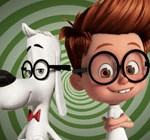 George Washington has made recent cameos for Dreamworks, both in their feature-length revival of Jay Ward’s Mr. Peabody and Sherman (3/7/14) (where George grants Peabody a presidential pardon – together withe Abraham Lincoln and Jimmy Carter), and in the rather dreadful 2D series, The Peabody and Sherman Show, where he sings a production number in at least the first episode. Portrayals of the father of our country have thus come full circle in their irreverence, parallel to his rowing off with Betty Boop in 1932.
George Washington has made recent cameos for Dreamworks, both in their feature-length revival of Jay Ward’s Mr. Peabody and Sherman (3/7/14) (where George grants Peabody a presidential pardon – together withe Abraham Lincoln and Jimmy Carter), and in the rather dreadful 2D series, The Peabody and Sherman Show, where he sings a production number in at least the first episode. Portrayals of the father of our country have thus come full circle in their irreverence, parallel to his rowing off with Betty Boop in 1932.
For a final (and slightly out of chronology) tip of the Revolutionary cap to this subject, a revisit is in order to a classic comedy album that was virtually a soundtrack looking for a cartoon – and in part ultimately found one. Stan Freberg’s The United States of America: Part 1 – The Early Years, from Capitol records, was a summit meeting of voice-over and radio comedians, most with long histories in the animation industry: Freberg himself (Junyer Bear, Pete Puma, Cecil the Seasick Sea Serpent), Paul Frees (Boris Badenov, Ludwig Von Drake, etc.), June Foray (Rocky the Flying Squirrel, Witch Hazel, Granny, etc.), Jesse White (C. Claudius Crow from Linus the Lionhearted), Walter Tetley (Andy Panda, Sherman, plus Leroy on the Great Gildersleeve and Julius Abrunzio on The Phil Harris Show), to name a few.
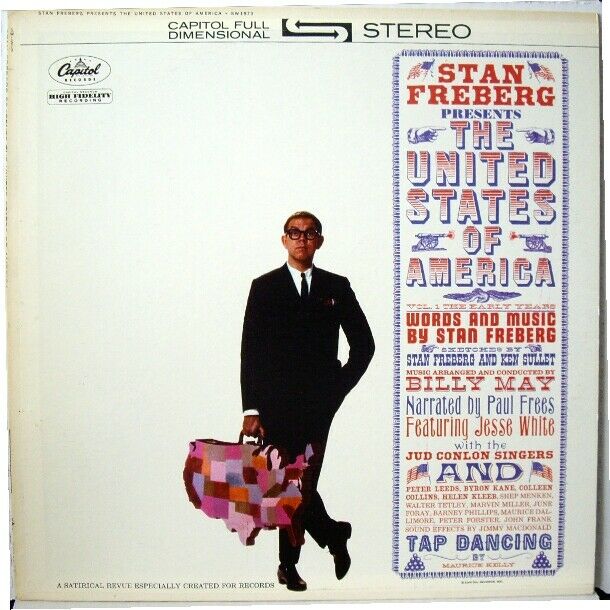
The album was a brilliant musical-comedy revue spanning the discovery of America through the American Revolution – with satiric send-ups of history that could easily put the average Peabody and Sherman episode to shame. Several highlights include Thomas Jefferson soliciting Ben Franklin for signature of the Declaration of Independence like a door-to-door pitch man circulating a petition for a ballot measure, and Franklin’s musical hesitation in a production number, “You Can’t Be Too Careful What You Sign These Days” – also including his misreading of Jefferson’s fancy penmanship as “Life, Liberty, and the Purfuit of Happineff.” The battle of Yorktown is won by subterfuge, with the use of a painted backdrop depicting thousands of fresh troops, painted by Franklin’s new kid artist, Norman Rockwell! And Cornwallis is more than willing to offer his sword in surrender in spite of the deception – realizing that the next day, England can apply to America for foreign aid. But one musical highlight finally found its way to the small screen by way of a fan-produced animated video by Toonsmyth Productions in 2011: “Stan Freberg’s America: The Spirit of ‘76″. In this classic bit, which includes glancing self-lampoons of previous hit Freberg singles, “The Yellow Rose of Texas”, “The Banana Boat Song”, and “The Great Pretender”, the fifer (named Bix) and second drummer rebel against lead drummer “Yankee Doodle” for being too “squaresville” in his approach, preferring a progressive jazz beat. Modern rhythm of course carries the day, with Doodle left in the dust. A well posed and designed visual interpretation for a fanfic production, which could easily rival or eclipse many musical moments produced on larger budgets for Seth McFarlane on Family Guy.
And thus, we conclude this salute to those patriotic animators of the past. To paraphrase the close of a Mighty Mouse episode, “They seen their duty – and they done it!”
